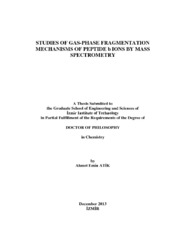Please use this identifier to cite or link to this item:
https://hdl.handle.net/11147/2959Full metadata record
| DC Field | Value | Language |
|---|---|---|
| dc.contributor.advisor | Yalçın, Talat | - |
| dc.contributor.author | Atik, Ahmet Emin | - |
| dc.date.accessioned | 2014-07-22T13:48:40Z | - |
| dc.date.available | 2014-07-22T13:48:40Z | - |
| dc.date.issued | 2013 | - |
| dc.identifier.uri | http://hdl.handle.net/11147/2959 | - |
| dc.description | Thesis (Doctoral)--İzmir Institute of Technology, Chemistry, İzmir, 2013 | en_US |
| dc.description | Includes bibliographical references (leaves: 111-132) | en_US |
| dc.description | Text in English; Abstract: Turkish and English | en_US |
| dc.description | xviii, 145 leaves | en_US |
| dc.description | Full text release delayed at author's request until 2017.01.13 | en_US |
| dc.description.abstract | This dissertation presents detailed studies of gas-phase fragmentation mechanism of peptide b ions under low-energy collision-induced dissociation (CID). Understanding the gas-phase structures and fragmentation mechanisms of the b ions is especially important for interpretation of peptide mass spectra. Recently, larger bn (n = 5, 6, 7...) ions are shown to form macrocyclic structures which can lead to erroneous in sequencing of unknown peptides. Therefore, in the first part of thesis, the effect of acidic amino acid residues (glutamic or aspartic acid) on the formation of macrocyclic structure is probed using various model hepta- and octapeptides. The results indicate that neither the presence nor the positions of acidic residues in peptides prevents macrocyclization of b ions. In addition, the dependence of preferential cleavage of acidic residues on applied collision energy is investigated for macrocyclic b ions. In the second part, the effect of ε-amine group of lysine residue is examined for the macrocyclization of b ions even if the N-terminal of the peptide is acetylated. The obtained results reveal that the macrocyclization is accomplished between ε-amine group of lysine and the oxazolone structure in the N-terminal acetylated peptide. Moreover, the lysine position is important parameter for the macrocyclization of b ions for N-terminal acetylated peptide. In the third and fourth parts of the thesis, the novel rearranged fragment ions are detected in the CID mass spectra of b ion series of acetylated lysine and side chain hydroxyl group containing model peptides, respectively. The gas-phase structures and fragmentation mechanisms of these novel fragment ions are investigated via multi-stage tandem mass spectrometry (MS4) experiments. In conclusions, the results presented in this dissertation can be used to elucidate the correct and reliable peptide sequences, and this improve protein identification strategies which is required for high-throughput proteomic studies. | en_US |
| dc.language.iso | en | en_US |
| dc.publisher | Izmir Institute of Technology | en_US |
| dc.rights | info:eu-repo/semantics/openAccess | en_US |
| dc.subject.lcsh | Peptides--Analysis | en |
| dc.title | Studies of Gas-Phase Fragmentation Mechanisms of Peptide B Ions by Mass Spectrometry | en_US |
| dc.type | Doctoral Thesis | en_US |
| dc.institutionauthor | Atik, Ahmet Emin | - |
| dc.department | Thesis (Doctoral)--İzmir Institute of Technology, Chemistry | en_US |
| dc.relation.publicationcategory | Tez | en_US |
| dc.identifier.wosquality | N/A | - |
| dc.identifier.scopusquality | N/A | - |
| item.openairecristype | http://purl.org/coar/resource_type/c_18cf | - |
| item.languageiso639-1 | en | - |
| item.openairetype | Doctoral Thesis | - |
| item.grantfulltext | open | - |
| item.fulltext | With Fulltext | - |
| item.cerifentitytype | Publications | - |
| Appears in Collections: | Phd Degree / Doktora | |
Files in This Item:
| File | Description | Size | Format | |
|---|---|---|---|---|
| 10013311.pdf | DoctoralThesis | 9.15 MB | Adobe PDF |  View/Open |
CORE Recommender
Sorry the service is unavailable at the moment. Please try again later.
Items in GCRIS Repository are protected by copyright, with all rights reserved, unless otherwise indicated.